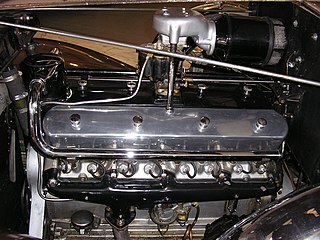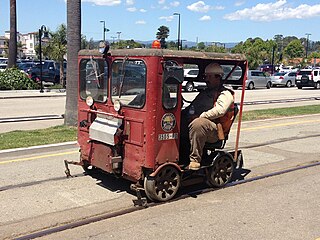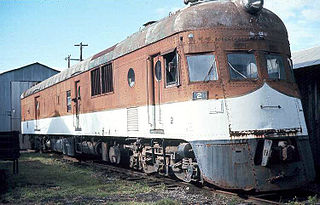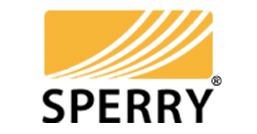
Fairmont is a city in and the county seat of Martin County, Minnesota, United States. The population was 10,438 at the 2020 census.

A hybrid vehicle is one that uses two or more distinct types of power, such as submarines that use diesel when surfaced and batteries when submerged. Other means to store energy include pressurized fluid in hydraulic hybrids.

A V16 engine is a sixteen-cylinder piston engine where two banks of eight cylinders are arranged in a V configuration around a common crankshaft. V16 engines are less common than engines with fewer cylinders, such as V8 and V12 engines.

A railcar is a self-propelled railway vehicle designed to transport passengers. The term "railcar" is usually used in reference to a train consisting of a single coach, with a driver's cab at one or both ends. Some railway companies, such as the Great Western, termed such vehicles "railmotors".

An opposed-piston engine is a piston engine in which each cylinder has a piston at both ends, and no cylinder head. Petrol and diesel opposed-piston engines have been used mostly in large-scale applications such as ships, military tanks, and factories. Current manufacturers of opposed-piston engines include Fairbanks-Morse, Cummins and Achates Power.

Montreal Locomotive Works (MLW) was a Canadian railway locomotive manufacturer which existed under several names from 1883 to 1985, producing both steam and diesel locomotives. For a number of years it was a subsidiary of the American Locomotive Company. MLW's headquarters and manufacturing facilities were located in Montreal, Quebec.

A railbus is a lightweight passenger railcar that shares many aspects of its construction with a bus, typically having a bus body and four wheels on a fixed base, instead of on bogies. Originally designed and developed during the 1930s, railbuses have evolved into larger dimensions, with characteristics similar in appearance to a light railcar, with the terms railcar and railbus often used interchangeably. Railbuses designed for use specifically on little-used railway lines were commonly employed in countries such as Germany, Italy, France, the United Kingdom and Sweden.

A speeder is a small railcar formerly used around the world by track inspectors and work crews to move quickly to and from work sites. Although slow compared to a train or car, it is called speeder because it is faster than a human-powered vehicle such as a handcar. Motorised inspection cars date back to at least 1896, when it was reported that the U.S. Daimler Motor Company created a gasoline-powered rail inspection car capable of 15 mph (24 km/h).

Fairbanks, Morse and Company was an American manufacturing company in the late 19th and early 20th century. Originally a weighing scale manufacturer, it later diversified into pumps, engines, windmills, coffee grinders, radios, farm tractors, feed mills, locomotives, and industrial supplies until it was purchased by Penn Texas in 1958.

General Motors Diesel was a railway diesel locomotive manufacturer located in London, Ontario, Canada. It was established in 1949 as the Canadian subsidiary of the Electro-Motive Diesel division of General Motors (EMD). In 1969 it was re-organized as the "Diesel Division of General Motors of Canada, Ltd." The plant was re-purposed to include manufacture of other diesel-powered General Motors vehicles such as buses. Following the Canada-United States Free Trade Agreement in 1989, all of EMD's locomotives were built at the London facility. In 2005 new owners of EMD renamed the Canadian subsidiary "Electro-Motive Canada". The plant was closed by EMD's new owner Progress Rail in 2012, with EMD's production remaining in LaGrange, Illinois and Muncie, Indiana.

The Consolidated line, or C-line, was a series of diesel-electric railway locomotive designs produced by Fairbanks-Morse and its Canadian licensee, the Canadian Locomotive Company. Individual locomotives in this series were commonly referred to as “C-liners”. A combined total of 165 units were produced by F-M and the CLC between 1950 and 1955.

The Hawaiian Railway Society is a 3 ft narrow gauge heritage railroad and railroad museum in Ewa, Hawaii, USA, on the island of Oahu. It uses the trackbed of the defunct Oahu Railway and Land Company. It is currently the only operating railroad museum in the U.S State of Hawaii.
The Erie-built was the first streamlined, cab-equipped dual service diesel locomotive built by Fairbanks-Morse, introduced as direct competition to such models as the ALCO PA and FA and EMD FT. F-M lacked the space and staff to design and manufacture large road locomotives in their own plant at Beloit, Wisconsin, and was concerned that waiting to develop the necessary infrastructure would cause them to miss out on the market opportunity for large road locomotives. Engineering and assembly work was subcontracted out to General Electric, which produced the locomotives at its Erie, Pennsylvania, facility, thereby giving rise to the name "Erie-built."

The OP800 was a lightweight, streamlined railcar built by the St. Louis Car Company in 1939. Fairbanks-Morse supplied the 800 hp (600 kW), five-cylinder 8 in × 10 in opposed piston engine prime mover. The units were configured in a highly unusual 2-A1A wheel arrangement (later converted to 3-A1A) mounted atop a pair of road trucks, and equipped with a front swing coupler pilot. The aft section was divided into two separate compartments: one was used to transport baggage and the other served as a small railway post office, or RPO.

Sperry Rail Service is a rail inspection company founded in 1928 by Elmer Ambrose Sperry. The company was the first in the world to offer nondestructive testing of railroad track. Since its formation, Sperry has been contracted by most of the major railroads in North America to inspect rail. To accomplish this task, the company operates a fleet of rail service vehicles that travel along railroads to detect defects.

The Museum of the American Railroad, formerly known as the Age of Steam Railroad Museum, is a railroad museum in Frisco, Texas. The museum has a large collection of steam, diesel, passenger, and freight railroad equipment, and is noted for allowing guests to walk through some of the equipment on guided tours. The President and CEO is Bob LaPrelle who has worked there for over 30 years now. It was established in 1963 for the Texas State Fair as the Southwest Railroad Historical Society. The collection accounts for over 70 trains; also in the collection are multiple historic structures.

The Texas Transportation Museum (TTM) is a transportation museum located in San Antonio, Texas.

The Roger Williams was a streamlined, six car, lightweight, DMU passenger train, built by the Budd Company in 1956 for the New York, New Haven and Hartford Railroad. The train was based on Budd's successful RDC DMU cars. The end two cars were equipped with streamlined locomotive style cabs and noses, resembling those on the Fairbanks-Morse P-12-42 Diesel locomotives. The four intermediate cars lacked operating controls and cabs.

















